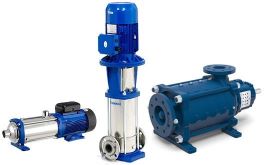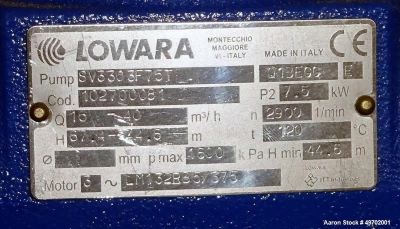With a fine line between irrigation and irritation, in the second in this series Peter Robinson − ICL technical area sales manager advising growers in the North West of England − turns his attention to pumps.
It is imperative pumping and irrigation systems are designed to provide the pressure and flow required for the different applications they are servicing. Pumping systems vary greatly and may have to cover hoses, spray lines and drip irrigation either individually, or in combination - all have very different flow and pressure requirements. Here we look at some indicators of where systems can be tailored to nursery requirements and how existing systems can be evaluated.
Firstly, pumps can broadly be divided into two categories – surface and underground/underwater pumps.
Surface Pumps
Available in numerous forms and formats, surface pumps range from stand-alone units to packaged booster sets. When designing a suitable pumping system, flow rate and pressure generated are the most obvious parameters to consider. Some systems need to cater for a large range of flows, while others might have identical flow rates for all areas.
- Pump Configuration
The two configurations commonly found on nurseries are vertical and horizontal. These can be single stage or, if more pressure is required, then more stages (impellers) can be specified.

- Hydraulic Performance
The flow rate of each pump can be identified from two pieces of data, usually found on the pump ID plate.

Q (Quantity) = upper and lower flow rates, usually in litres per second or per minute or m3 per hour.
H (Height) = upper and lower pressure range, normally given in metres (10m = 1 Bar).
- Pump Sets
These can be two or more pumps with identical, or different, performances depending on the application. Sometimes a small lead pump covers small flows, such as hose watering, with a larger pump (or pumps) to bring in when duty dictates.
- Fixed or Variable Speed?
As their name suggests, fixed speed pumps run at full motor speed. These can be inefficient if full performance is not required or there are variable flow rates to cover. Fixed speed pumps are commonly used in conjunction with a pressure relief system, to exhaust water back to the supply tank.
In contrast, variable speed units have a sensor in the pressure system enabling the invertor drive to run the motor at the correct speed to maintain the performance required. Inverters can be pump manufacturer units supplied with the pump/retrofitted (eg Hydrovar/Capdrive) or a bespoke panel specified for the power rating of each pump (eg Vacon/Danfos).
Both fixed and variable speed booster sets can be configured to run duty and assist, when one pump starts with the other(s) coming on as required. Alternatively, to run duty and standby with one pump working for the duration of the irrigation event; the other pump taking the next programme and so on.
Rotating duty is also common where the lead pump switches after each irrigation event through all the pumps in the set.
Submersible or Underground Pumps
Less common for supplying nursery irrigation systems direct, these pumps are generally found where a borehole, or open water source (eg river/pond/reservoir), is filling the supply tank. The usual configurations are shown below and can deal with clean water, or more dirty water, often in combination with a filtration system. Borehole pumps tend to be higher pressure units, while submersible pumps usually transfer water through relatively small height differences.
- Control Systems
Pumps and booster sets can be controlled by a pressure switch, a pressure transducer or by multiples of for booster systems. Pressure switches are usually used for fixed speed equipment with transducers controlling variable speed equipment.
- Pressure Vessels
Booster set pressure vessels act as a buffer. A pump is designed to supply a variable volume of water at a constant pressure. For example on a nursery there may be anything from a single tap running, needing a tiny quantity of water, to several systems operating needing lots of water. In either case they need water pressure.
Most modern pumps achieve this by having a pressure sensor in the pipework. As soon as the demand starts (eg tap turned on) the water pressure in the system drops and the pump/s ramp up until the pressure is maintained. When the demand stops (eg tap turned off) the water pressure starts to climb, the pump/s ramp down and stop.
The problem can be the lag after turning the tap on and waiting for the pump to start. There can also be a pressure surge when the tap turned off, potentially bursting a joint. To aleviate this, the pressure vessel provides instant pressure when the tap is opened and takes up the slack again when the tap is closed. It also helps maintain pressure, for instance when a system has minor leaks, rather than the pump regularly recharging the system.
This is the last Technical Matters for 2019. In the New Year we will be continuing the irrigation or irritation theme and Peter will be taking a closer look at dosing systems and then filtration.
For Part 1 of this article please click here
